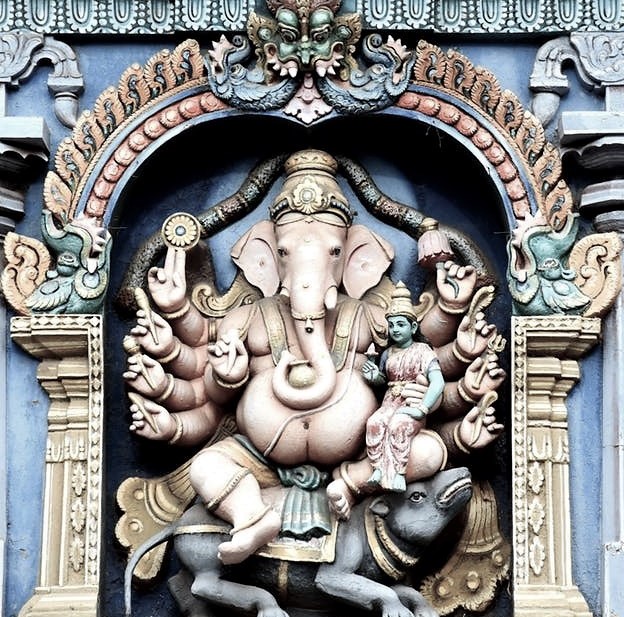- Special FeaturesFoundation Year500 - 1000 years oldSthala TreeTheerthamRathamArchitectureOther Speciality
- Sthala Puran
Though the legends related to the origin of a place cannot be deemed as its history, the story on the evolution of Mannarasala as one of the foremost places of worship of the Serpent Gods is associated with Lord Parashurama who is widely believed to be the creator of Kerala. This history of Mannarasala has been mentioned in the 'Mandara Salodyam', a Sanskrit poem written by Mannarasala M.G. Narayanan Namboothiri of the sacred family based on the accounts and legends handed down and old scriptures and books available with the temple.
Many generations passed by. The family fell into the grief of childlessness. Vasudeva and Sreedevi were the sad couple who had to bear that heavy load of sorrow, who resolutely worshiped Nagaraja to allay their grief. It was about this time that unexpectedly fire broke out in the jungle around the dwelling place of Nagaraja and burnt down the jungle. The serpents were tortured by the flames, forcing them to hide in their pits with great difficulty. Vasudeva and Sreedevi looked after the serpents, who had their hoods charred, bodies half-burnt, and fainting from time to time, falling down and crawling along. They gently fanned them with fans made of sweet-scented grass and poured ghee mixed with honey and oil on the wounds; cooled their melted bodies with sandalwood ointment; and comforted them. They put them at the foot of banyan trees. They performed purification ceremonies and consecrated the pits; and were put up in special places under the shade of deodar trees and in Chitrakudas. The couple performed abhisheka with theertha like Panchagavya (a holy mixture of five items from the cow's milk, curd, butter, urine and dung); observed elaborate poojas according to rules with areca nut flower bunches, fragrant flowers and water, incense etc., Nivedyam with melted butter (ghee), milk, payasam with molasses, rice powder, turmeric powder, coconut juice, Kadali fruit, cow's milk, all mixed together in the proper form as Nurum Palum, equivalent to the elixir of life. They offered serpent deities with great devotion, appam, aval (beaten rice or rice wafers), tender coconut etc. They chanted vedic mantras, performed homams and all kinds of poojas to restore those crowds of serpents to full health. The omnipresent and omnipotent Nagaraja was greatly pleased with their continuous penance and the love shown to his associates; Nagaraja made himself visible to the couple and blessed them that he would incarnate on the earth as their beloved son. He said " I shall assume the form of a serpent and stay here (in Mannarasala) permanently, as long as the sun and the moon are there, showering prosperity on your family and granting protection to all the devotees who come here …". Thus Mandarasala, the place filled with Mandara trees, the holy spot where the serpents got shelter, where the earth was fully cooled, became Mandarasala. The boon came true. The Brahmin lady became pregnant and gave birth to five-hooded serpent-child as well as a human child. The two brothers grew up together. Initiation ceremonies and Vedic education were carried out at the proper time in the traditional style. Nagaraja instructed the younger brother to enter into matrimony for the perpetual reservation of the holy family and he obeyed it. When the five-hooded Nagaraja realized that the objectives of his incarnation were realized, he informed the Holy Mother that henceforth he would live at this Illam by entering into Samadhi to bless the devotees. Then he suggested certain inviolable rituals and rules for offering worship and then went into the immaculate cellar and vanished. (It is believed that even today that five-hooded Nagaraja stays in the cellar doing Tapas for the abound prosperity of his dependents. The members of the household always refer to him with great respect and devotion as "Muthassan" and "Appoppan" (Grand father). The jungle close by is the exclusive preserve for his unobstructed peregrinations (Appoppan Kavu - Grandfathers' Grove).
- Architecture
- Alankar of Deity
- Prayers and BenefitsSpecial Vratas and Prayers
Couples seeking fertility come to worship here, and upon the birth of their child come to hold thanksgiving ceremonies here, often bringing new snake images as offerings. A special turmeric paste which is available at the temple is credited with curative powers.
Offerings to DeityThe Uruli Kamazhthal offering with devotion and prayers, has helped numerous devotees to have children, who come to this temple.
Main offerings:
For wealth and prosperity: A pot filled with gold or a gold pot filled with other things.
For education, prosperity and fame: Silk grains, divine ornaments.
For recovering health: Salt
For protection from poison: Turmeric
For curing diseases: Pepper, mustard, green peas etc.
For protection from damage: Serpent cave made of gold etc., images of serpents eggs, tree, earth etc.,
For long life: Melted butter (ghee)
For getting whatever one wants: Milk, ripe kadalai fruit, nilavarapayasam.
For having child: A vessel named Uruli made of brass, bronze etc. for performing Nurum Palum.
Stotras and Mantras
- FestivalsMannarasala AyilyamMannarasala Ayilyam is the main Temple festival. On the day of Ayilyam asterism in the months of Kanni and Thulam (September and October), all the serpentine idols in the grove and the temple are taken in procession to the Brahmin illom, where the offerings of Nurum Palum (rice flour and milk), Kuruthi (a red liquid made of turmeric and lime) and cooked rice are made. The matriarch of Mannarasala Illom carries the idol of the Nagaraja and the procession is conducted with great pomp and rejoicing.MahasivaratriAnnual pooja in NilavaraDeeparadhana
- Sodasha Upcharas
- Prasadhas
- Social ActivitiesAnnadhanMarriageEar BoringHead ShaveDanaasEducation FacilitiesSocial DrivesOther Activities
- Arjita Seva
- Tags

